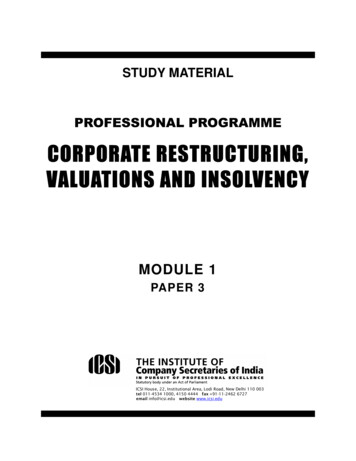
Transcription
Some Basic Aspects of the Agreements Between Israel andthe PLO from the Perspective of International LawPeter Malanczuk*I. IntroductionThe Middle East peace process is a complex web of international negotiations basedupon the structure set up at the Madrid Conference that was held on 30 October1991 and was co-sponsored by the United States and Russia (then the USSR).1There are two different but parallel negotiating tracks, a bilateral one and a multilateral one. The bilateral track consists of four separate sets of direct negotiations between Israel, and Syria, Lebanon, Jordan and the Palestinians. The multilateral trackaims at building confidence among the regional parties and at solving a number ofcomplicated issues which are addressed in five different forums comprising representatives from states in the region as well as of the international community. Theworking groups of the multilateral negotiations are focusing on water, environment,arms control, refugees and economic development.2 With regard to the bilateralnegotiations between Israel and the three Arab States, the purpose is to concludepeace treaties, which in the case of Jordan has been accomplished with the PeaceTreaty signed on 26 October 1994.3The most interesting bilateral negotiations from an international legal perspectiveare those between Israel and the Palestinians.4 It is upon some of the basic legal*1234Department of International Relations and Public International Law, Faculty of Political andSocio-Cultural Sciences, University of Amsterdam.See P. Malanczuk, 'Israel: Status, Territory and Occupied Territories', EPIL II (1995), 1468-508,at 1501-8; The Middle East Peace Process, An Overview, Information Division, Ministry of Foreign Affairs, Jerusalem, December 1995. For a general legal analysis see E. Cotran and C. Mallat(eds), The Arab-Israeli Accords: Legal Perspectives, (1996) (the book was not yet available at thetime of writing).See also M. Cogen and A. Francois, 'Realizing the Right to Self-Determination of the PalestinianPeople: The European Union and the Peaceful Settlement of the Israeli/Palestinian Conflict', in N.Sybesma-Knol and J.V. Bellingen (eds), Naar een nieuwe interpretatie van het Recht op Zelfbeschikking (1995) 345-73.Text in ILM 34 (1995) 43.See , for example, the contributions by E. Benvenisti, "The Status of the Palestinian Authority',and by E. Cotran, 'Some Legal Aspects of the Declaration of Principles: A Palestinian View', inThe Arab/Israeli Accords, supra note 1; E. Benvenisti, "The Israeli-Palestinian Declaration of7 EJIL( 1996) 485-500
Peter Malanczukaspects of these negotiations and their results so far that the present article concentrates. Within the limited scope of this article, it is impossible to address the complicated legal details of the process, including the diverse issues addressed in the agreements already in force and those which have been postponed to a later stage. Thearticle, therefore, selects some more basic aspects of the agreements between Israeland the PLO with the purpose of examining the relevance of international law and ofhighlighting some of the more fundamental legal issues. Following a general overview of the bilateral and multilateral legal framework of the peace process in sectionII, it discusses the legal nature of the agreements between Israel and the PLO - section III. It then, in section IV, addresses the legal effect of the arrangements upon thebasic relationship between the parties and upon the status of the West Bank andGaza (section V). It further examines the relevant dispute settlement mechanisms(section VI). The article concludes with some reflections on the role of internationallaw in the Middle East peace process in general (section VII).II. The Bilateral Legal FrameworkThe historic event of the Israeli-Palestinian accord was formalized at a ceremony inWashington on 13 September 1993 where the Declaration of Principles on InterimSelf-Government ('DOP') was signed by the Israeli Prime Minster Rabin and byPLO Chairman Arafat.5 The DOP has four annexes concerned with elections, earlywithdrawal from the Gaza Strip and Jericho area, Israeli-Palestinian economic cooperation, and cooperation at the regional level. In addition, there are 'Agreed Minutes' which, as an 'integral part' of the Declaration, amplify various of its provisions. Finally, the Declaration is supplemented by an exchange of letters, dated 9September 1993, which, inter alia, confirm the recognition by the PLO of Israel'sright to exist, of the renunciation of terrorism and an undertaking to amend the Palestinian Covenant and the recognition by Israel of the PLO as the representative ofthe Palestinian people.The ultimate aims of the Declaration, as stated in the preamble, are to 'put an endto decades of confrontation and conflict and to live in peaceful coexistence, mutualdignity and security' and to 'achieve a just, lasting and comprehensive peace settlement and historic reconciliation'. The parties further accepted that 'the peace process . as well as the new relationship established between the two Parties . areirreversible'. The Declaration is not a comprehensive arrangement with practicalresults, but rather a statement of agreed principles to guide a negotiating processthrough several stages to establish the 'agreed framework for the interim period'5486Principles: A Framework for Future Settlement', EJIL 4 (1993), 542-54; R. Shihadeh, 'Can theDeclaration of Principles Bring About a "Just and Lasting Peace"?', ibid., 555-63; A. Cassese,'The Israel-PLO Agreement and Self-Determination', ibid., 564-71.Declaration of Principles on Interim Self-Government Arrangements, Government of Israel,Ministry of Foreign Affairs, September 1993.
Basic Aspects of the Agreements between Israel and the PLO(Article II). An 'interim' or 'transitional period' of 5 years is envisaged until theimplementation of the permanent status arrangements. The time-frame is based onthe one included in the 1978 Camp David Accords, concluded between Israel andEgypt, although these are not mentioned due to Palestinian objections. The interimperiod starts with the withdrawal of Israeli forces from Gaza and the Jericho area(Article V). Negotiations on the final status of the West Bank and Gaza are scheduled to commence at the beginning of the third year of this five year period at thelatest.The Agreement on the Gaza Strip and the Jericho area, signed in Cairo on 4 May1994 (Gaza-Jericho Agreement)6, marked the first stage of implementing the DOPprovisions dealing with the withdrawal of Israeli military forces from the Gaza Stripand the Jericho Area and the transfer of powers to a Palestinian authority, the members of which at this stage were not elected but appointed by the PLO with the approval of Israel. With regard to the West Bank, the DOP envisaged some 'EarlyEmpowerment' arrangements concerning this area as the second stage of implementation. On 29 August 1994, Israel and the PLO accordingly signed an Agreement on the Preparatory Transfer of Powers and Responsibilities providing for thetransfer of six civil spheres to the Palestinian Authority. An additional eight sphereswere likewise transferred on the basis of a Protocol on Further Transfer of Powersand Responsibilities, signed on 27 August 1995. The third stage of implementationof the DOP was reached with the Interim Agreement on the West Bank and the GazaStrip, which was signed in Washington on 28 September 1995 (Interim Agreement).7 This agreement intends to extend arrangements made for Palestinian selfgovernment in the Gaza Strip and the Jericho area throughout the West Bank. TheInterim Agreement is a complicated document of more than 300 pages and includesseven annexes. It lays down detailed provisions on the election of the PalestinianCouncil and provides for the transfer of powers andresponsibilitiesto the Council aswell as for extensive arrangements on security issues, including the redeployment ofIsraeli military forces in the West Bank, which issue is partly also addressed in thenine maps attached to the agreement. Furthermore, the relations between Israel andthe Palestinian Council are addressed with regard to legal and economic matters. Italso sets out a framework for enhancing cooperation between the two parties anddeals with the release of Palestinian prisoners and detainees.Agreement on the Gaza Strip and the Jericho Area, Cairo, May 4, 1994, Ministry of ForeignAffairs, Jerusalem.Israeli-Palestinian Interim Agreement on the West Bank and the Gaza Strip, Washington, D.C.,September 28, 1995, Ministry of Foreign Affairs, Jerusalem. See J. Singer, The West Bank andGaza Strip: Phase Two, Justice' - The International Association of Jewish Lawyers and Jurists No.7 December 1995, 5-17. The Interim agreement was witnessed and countersigned by the heads ofStates, foreign ministers or representatives of the United States, the Russian Federation, Egypt,Jordan, Norway and the European Union.487
Peter MalanczukIt is important to note that arrangements made by the Interim Agreement incorporate or supersede all of the provisions made in the three earlier agreements.8 Thenew arrangements remain in force throughout the five year transitional period whichstarted from the date on which the Gaza-Jericho Agreement had entered into force (4May 1994) and thus shall be completed by 4 May 1999. Negotiations on permanentstatus issues are to commence not later than the third year of the interim period.9The Interim Agreement specifies this date as 4 May 1996.10 Issues to be addressedin the permanent status negotiations include 'Jerusalem, refugees, settlements, security arrangements, borders, relations and cooperation with other neighbours andother issues of common interest'.11 The permanent status arrangements arisingfrom the negotiations are to be implemented at the end of the five year transitionalperiod.III. The Legal Nature of the Agreements Between Israel and thePLOWhile the Peace Treaty between Israel and Jordan (as in the case of the Camp DavidAgreements between Israel and Egypt) is clearly a treaty between states governed byinternational law in the sense of the 1969 Vienna Convention on the Law of Treaties 12 , the legal nature of the agreements between Israel and the PLO is a matter ofdispute. Some authors argue that '[t]he PLO's lack of status as a state precludescharacterization of the Declaration as a treaty or international convention, and henceas a hard law instrument in the traditional sense.'13 It is suggested that it is 'rather anagreement between the State of Israel and the PLO, 'representing the Palestinianpeople" and that '[bjecause the Declaration of Principles accepts some, but not all,elements of Palestinian statehood, Palestine may be considered a 'quasi-state' forpurposes of the agreement; that is an entity enjoying certain prerogatives ordinarilyreserved to states, but not fulfilling all of the traditional prerequisites for statehood.' 14 The same author concludes that, although the agreement is 'a soft lawdocument in the traditional sense', it nevertheless is 'an agreement with considerablebinding force' which 'appears on close analysis to embody a solid, substantive ac-891011121314488The arrangements made for the Gaza Strip were generally kept, except for some modificationsgained from the experience with the implementation of the Gaza-Jericho Agreement. The arrangements for the Jericho area were replaced by the new arrangements designed for the WestBank as a whole. Under the Interim agreement the Palestinian Council assumes the powers and responsibilities transferred to the Palestinians under the preparatory transfer agreements.Art. V. DOP.Art. XXXI(5) Interim AgreementArt. V(3) DOP.Text in: I. Brownlie, Basic Documents in International Law, 4th ed. (1995) 388.Note, 'The Israel-PLO Declaration of Principles: Prelude to a Peace?', Va. J. int'I. L 34 (1994),435-69, at 452.Ibid., 465.
Basic Aspects of the Agreements between Israel and the PLOcord'.15 Other authors have also expressed doubts (at least) on whether the IsraelPLO agreements are international instruments.16In the view above there is some confusion on two different issues which need tobe distinguished in the analysis. The first issue concerns the law to be applied to theagreement, in particular, whether it is an agreement concluded under internationallaw. The second issue is whether, or to what extent it is a legally binding or nonbinding agreement, and what the legal consequences of it are.With regard to the first issue, it is correct that the PLO is not a state in the senseof international law and that it also does not represent any existing State of'Palestine'. The establishment of a 'State of Palestine' was proclaimed with theAlgiers Declaration of 15 November 1988 and it was recognized by many formercommunist states and developing countries which entered into diplomatic relationswith the representatives of this state. However, this 'State of Palestine' does notfulfill one of the essential criteria under international law for the existence of a state 17 because there is no effective sovereign control over the territory and populationclaimed to form the basis of the 'State of Palestine'.18This does not mean that the Israel-PLO agreements cannot be treaties underinternational law. It is true that the 1969 Vienna Convention on the Law of Treatiesonly applies to treaties concluded between states. But that does not affect, as expressly acknowledged in Article 3 of the Convention, the legal validity of, and theapplication of international rules on the law of treaties to, agreements concludedbetween states and other 'subjects of international law'.19 Independently of theattitude taken by Israel towards the PLO in the past20, in international practicethe latter has become recognized as a national liberation movement21 with the rightto self-determination22, which, although it does not exercise effective territorialjurisdiction, is a partial subject of international law with the legal capacity to maintain diplomatic relations with states and international organizations recognizing itand to conclude treaties. As a partial subject of international law, the PLO is notequal to a state, but that does not affect the validity of a treaty it concludes with astate.23151617181920212223Ibid., 467.See, for example, Y Z Blum, 'From Camp David to Oslo', Israel LR 28 (1994), 211, at 212-3.See generally' P.Ma\anczuk,Akehurst's Modem Introduction to International Law, 7th ed. (1997)Ch. 5 (forthcoming).See Malanczuk, supra note 1 at 1491-2; Boyle, "The Creation of the State of Palestine', EJIL 1(1990) 301; J. Crawford, "The Creation of the State of Palestine: Too Much Too Soon?', ibid., 307.For the text of the Convention see supra note 12.Even Israeli authors agree that the international status of the Palestinian people, and the PLO as itsrepresentative, was not dependent upon recognition by Israel, see E. Benvenisti supra note 4 at544. See also ICC. Goller, 'Legal Analysis of the Security Arrangements Between Israel and thePLO', Israel LR 28 (1994), 236, at 239 note 9.See F.L.M. Van de Craen, 'Palestine Liberation Movement', EPIL 12(1990) 278-82.See, for example, PJ. de Waart, Dynamics of Self-Determination in Palestine: Protection of Peoples as a Human Right, (1994).See also F.A.M. Alting von Geusau, 'Breaking Away Towards Peace in the Middle East', LeidenJournal of International Law 8 (1995), 81-101,91-3; Benvenisti supra note 4 at 544-5.489
Peter MalanczukYehuda Blum argues that, even if one would be prepared to recognize that national liberation movements could have the status as subjects under internationallaw, 'it does not necessarily follow that agreements entered by them become international agreements; partial and limited subjects of international law logically haveonly partial capacities under that law.' 24 This argument is not convincing for diefollowing reasons. If die Israel-PLO agreements are not international agreementsunder public international law, then they must be governed by some national legalsystem, as in the case of so-called 'state contracts' concluded by a host state and aforeign company (unless, as more frequently in the past, a reference in the contractis made to international law as the governing law, which does not necessarily elevatethe contract to the level of a treaty in the international law sense).25 Quite apparently, this would lead to absurd results.Moreover, there are two clear indications in the agreements themselves that theparties consider them to be international law agreements. First, there is express reference in some provisions that certain action has to be taken 'in accordance withinternational law'. Second, as will be discussed below, the methods of dispute settlement provided for in the agreements are the typical ones of international law dispute settlement procedures. An additional argument can be found in the facts that theUnited Nations has endorsed the Israel-PLO Accord, that other states have signed aswitnesses and that a multilateral international framework has been created in supportof the Middle East Peace process, all of which does not lend support to the view thatdie agreements are non-international ones. The agreements made between Israel andthe PLO include the recognition by Israel of the PLO as the representative of thePalestinian people, and thereby are clearly governed by international law.The second issue is: what kind of agreements are these under international law?Although the DOP is entitled 'Declaration', its content reveals that the parties didnot want to enter into a mere 'gentlemen's agreement' or just intended a declarationof policy. There is, furthermore, no reason to consider whether the text could bequalified as non-binding on the grounds that it lacks precision, in the sense thatJudge Lauterpacht argued in his declaration attached to the Judgment of the International Court of Justice in the Sovereignty of Certain Frontier Land case, namely that'the . provisions . must be considered as void and inapplicable on account of uncertainty and unresolved discrepancy'.26 First, the view held by some authors thatthe vagueness of treaty provisions may lead to the conclusion that these provisionsare not legally binding is in itself incorrect. If the parties intended to conclude atreaty, then it is binding as a whole, even if some parts contain broad or unclearlanguage. Vague provisions may give the parties a broad margin of discretion, but,as Bernhardt notes, that is not to say that they are without legal significance andbinding substance.27 Secondly, even if one would like to take the contrary view, the24252627490Supra note 16 at 213.See Malanczuk (1997), supra note 17, Ch. 6.ICJ Reports 1959, 209, at 231.See R. Bernhardt, 'Treaties', EPIL 7 (1984), 459-64, at 461.
Basic Aspects of the Agreements between Israel and the PLOdetailed nature of many of the obligations laid down in the Israel-PLO agreements(especially after the DOP) clearly show that the provisions are sufficiently clear andthat the parties intended to inter into binding commitments and not merely concludea non-binding agreement28 This is also true with regard to the agreement to laternegotiate on the permanent status. It is generally accepted that an obligation to takepart in negotiations and to conduct them in good faith 'may form the valid and practical object of an international undertaking'.29There are other arguments supporting the view that the agreements between thePLO and Israel are legally binding ones. First, if they were supposed to be nonbinding it would not have been necessary to include dispute settlement provisionswhich also provide for the option of arbitration which is a form of legally bindingthird-party settlement.30 Secondly, it has also been argued by the parties themselves(at least by the Israeli side) that the disrespect of fundamental provisions of theagreement by one party may result in the right of the other party to terminate it.31This only makes sense if the agreement is considered a legally binding treaty, because if it is a non-binding agreement there is logically no need to terminate it; thereare no obligations in the legal sense anyway. Finally, also in view of the nature ofthe issues to be settled between the parties, it is hardly conceivable that either of theparties would like to understand the commitments made as merely non-binding onesfrom which one side could withdraw at will.The parties to the Israel-PLO agreements have laid down very specific obligations for the transitional period and concluded a pactum de negotiandoregardingthepermanent status with very clear time-limits. The agreements in their entirety are'hard law' and not any kind of so-called 'soft law'32, even withregardto the agreement to negotiate on the permanent status. Although an agreement to negotiate doesnot necessarily imply an obligation to reach an agreement, it implies that seriousefforts towards that end must be made33. The parties are legally obliged to make useof all available means of negotiation in good faith with a view of achieving a definite substantive agreement and they must continue or even renew these negotiationsas long as one side insists on further discussion and the other side cannot rely on avalid ground recognized in the law on treaties for terminating a treaty or withdrawing from its operation.34 It can be further argued that this is even true in cases in28293031323334See F. MUnch, 'Non-Binding Agreements', EPIL 7 (1984), 353-8. With regard to the DOP,Cassese, supra note 4, distinguishes between three classes of legal commitments: obligationswhich become immediately operative, obligations to conclude agreements (pacta de contrahendo)and obligations to negotiate future agreements (pacta de negotiando).Judge De Visscher in his dissenting opinion to the ICJ's Advisory Opinion of 11 July 1950 onSouth West Africa, ICJ Reports 1950,186, at 188.See text below.See Singer, supra note 7.On the confusing concept of "soft law" see Malanczuk supra note 17, Ch. 3.See the decision of the Tribunal in the German External Debts Arbitration, ELR 47 (1974), 418, at4453-4. See further U. Beyerlin, 'Pactum de contrahendo, Pactum de negotiando', EPJX 7 (1984)371-6.See M. Akehurst, 'Treaties, Termination1, EPIL 7 (1984), 507-10.491
Peter Malanczukwhich the parties have set a fixed date for the accomplishment of their mutual obligation to negotiate. Thus, Israel and the PLO can be viewed as being under a legalobligation to continue with their negotiations on permanent status even if not allissues have been solved by the deadline set in 1999. In addition, while negotiationsare in progress the parties are obliged to refrain from acts which would frustrate theobject of the intended agreement.IV. The Legal Effects of the Agreements on the Basic RelationshipBetween the PartiesThe basic relationship between Israel and the PLO has been fundamentally alteredby steps of legal recognition, barring them in the future from treating each otheronly as de facto entities. 35 The process of legal recognition commenced with theletter from the PLO chairman Arafat of 9 September 1993 stating that 'the PLOrecognizes the right of the State of Israel to exist in peace and security.' The PLOfurther renounced the use of terrorism and other acts of violence. It also affirmedthat 'those articles of the Palestinian Covenant which deny Israel's right to exist.are now inappropriate and no longer valid' and undertook to initiate the requiredchanges in the Covenant. In his reply letter of 9 September 1993, Israel's PrimeMinister confirmed, in view of the commitments made by the PLO that 'the Government of Israel has decided to recognize the PLO as the representative of the Palestinian people.'.There has been some discussion in the literature on the legal nature of these letters, especially on whether they constitute unilateral promises which, as such, arelegally binding. 36 In the present author's view, it would be more accurate to regardthe exchange of these letters as constituting a binding international agreement initself because the obligations undertaken are not unilateral in nature but based uponreciprocity leading to the agreement, as expressed in both letters, to commence negotiations on a peace settlement.37 However, the issue has lost its practical significance since the undertakings expressed in the letters of 9 September 1993 have beenincorporated by reference in the 1994 Cairo Agreement which is clearly a bilateralagreement. 38In renouncing terrorism and the use of force (between which a definite line is notalways easily drawn) the PLO has rendereed moot the controversial issue of theextent to which international law and the principle of self-determination permits the35363738492See J.A. Frowein, 'De facto Regime', EPDLI (1992), 966-8.See Goller, supra note 20, 237 et seq.An international agreement can be based on or reflected by several separate documents. A unifiedtext signed by both parties is not required. International agreements can even be concluded orallywith binding force, although this is, of course, for reasons of evidence among others, not the rulein practice.See Goller, supra note 20 at 247 et seq.
Basic Aspects of the Agreements between Israel and the PLOuse of armed force in so-called wars of national liberation, and the intervention bythird states in support of such wars.39 The PLO has agreed to pursue its goal of independent statehood through peaceful negotiations and thereby renounced, withlegally binding effect, any right it may or may not have had to use the methods itemployed in the past In explicitly recognizing Israel's right to exist in peace andsecurity (which is accepted under general international law and by the internationalcommunity irrespective of the status of the occupied territories)40, the PLO has alsowaived any claim to replace Israel by a Palestinian State. The Covenant of the PLOwas, in fact, amended accordingly in May 1995.Israel, on the other hand, if the PLO respects the obligations it has undertaken,no longer can invoke the right to use armed force, Article 51 of the UN Charter, orany customary international law right of self-defence vis-a-vis the PLO.41 Israel hasalso accepted the obligation to settle the problems with the PLO in peaceful negotiations. Furthermore, Israel has explicitly accepted in the DOP that the 'legitimaterights of the Palestinian people' must be realized in the permanent status negotiations.42While this may be interpreted as an indirect reference to the right of the Palestinian people to self-determination43, it is known that the views of the parties on themeaning of this is quite divergent. While the Palestinian side envisages an independent State of Palestine with at least part of Jerusalem as its capital, the Israeli sideprefers some form of Palestinian autonomy (or 'self-government') only, perhapswithin a confederation with Jordan, and insists on keeping an undivided Jerusalemas its capital. Legally speaking, between the parties the matter is kept deliberatelyopen and the outcome will depend on the permanent status negotiations.Although there is an agreement to disagree on these and other issues for the timebeing, this does not mean that the Palestinians have given up their right to selfdetermination in the sense of to 'freely determine their political status'. The PLO hasmerely agreed to suspend the full exercise of the right (in the sense of claiming independent statehood) until the completion of the negotiations on permanent status.The Palestinian right to self-determination remains legally limited by the provisionsof the agreements so far reached with Israel. As long as these arrangements remainlegally in effect and are not suspended or terminated on a valid ground under the lawof treaties, the highly controversial notion of self-determination, its precise meaning3940414243See H. Wilson, International Law and the Use of Force by National Liberation Movements,(1988).See Malanczuk, supra note 1.See generally P. Malanczuk, 'Countermeasures and Self-Defence as Circumstances PrecludingWrongfulness in the International Law Commission's Draft Articles on State Responsibility', in:M. Spinedi and B. Simma (eds). United Nations Codification of State Responsibility, (1987) 197286.Article m(3) DOP.For a discussion see Cassese, supra note 4.493
Peter Malanczukin international law and its exact legal consequences 44 are not of practical relevancefor the peace process. At any rate, it is also an exercise of the right to selfdetermination that the PLO, as representative of the Palestinian people, has decidedto pursue the specific course of the negotiations with Israel.The above conclusion is supported by a provision in the Interim Agreementitself, which provides:Nothing in this Agreement shall prejudice or preempt the outcome of the negotiations onthe permanent status to be conducted pursuant to the DOP. Neither Party shall bedeemed, by virtue of having entered into this Agreement, to have renounced or waivedany of its existing rights, claims or positions.45A s correctly noted by the Israeli side, interim arrangements are interim arrangementsonly:[T]hey are not in any way intended to influence the outcome of the permanent status negotiations. In other words, in the upcoming permanent status negotiations, no party maybe barred from raising a claim or argument regarding the permanent status merely because that party has agreed in the Interim Agreement that a different arrangement may beimplemented during the interim period.46V. The Legal Effects of the Agreements on the Status of the WestBank and GazaThe legal status of the territories occupied by Israel since 1967 is controversial47.The basic positions of the parties with regard to the areas currently designated forPalestinian autonomy under the arrangements can be briefly
Agreements between Israel and Egypt) is clearly a treaty between states governed by international law in the sense of the 1969 Vienna Convention on the Law of Trea-ties12, the legal nature of the agreements between Israel and the PLO is a matter of dispute. Some authors argue that '[t]he PLO's lack of status as a state precludes











